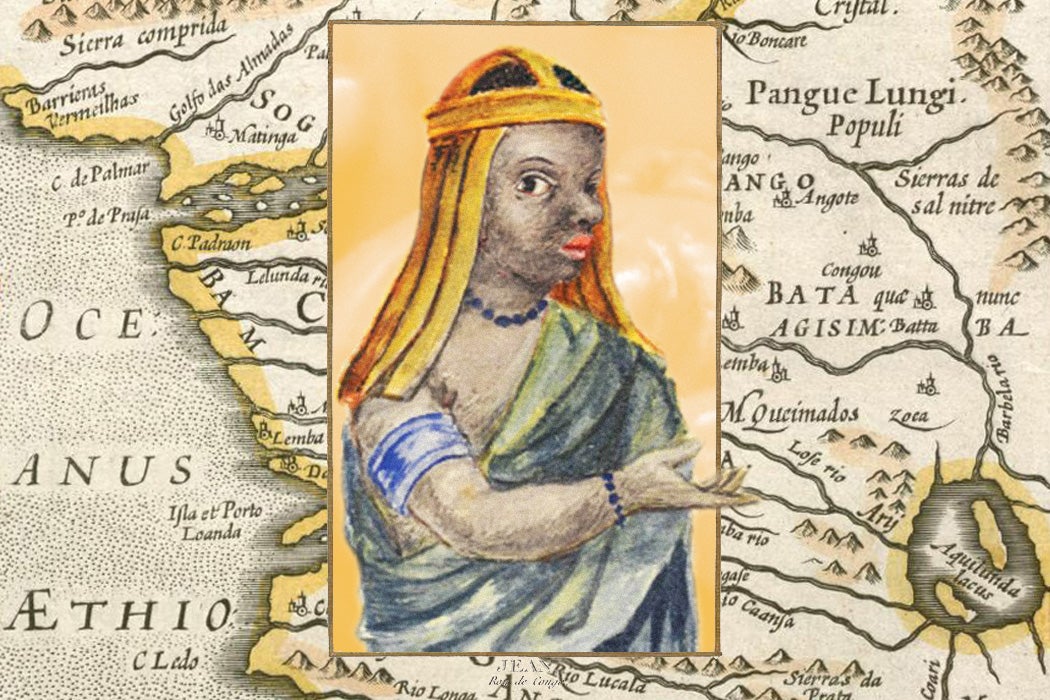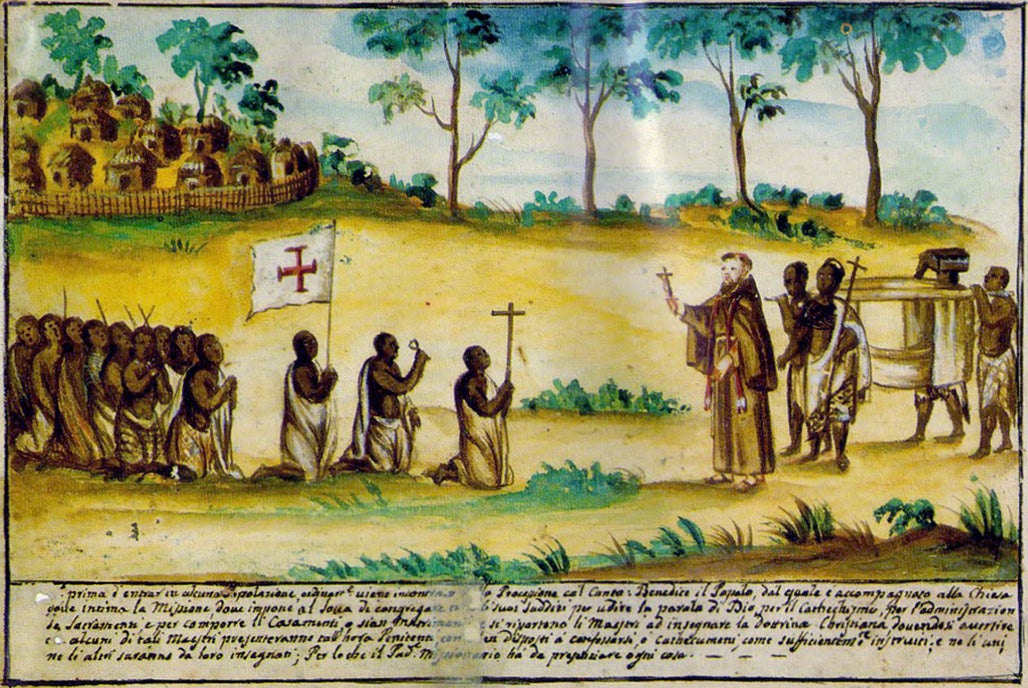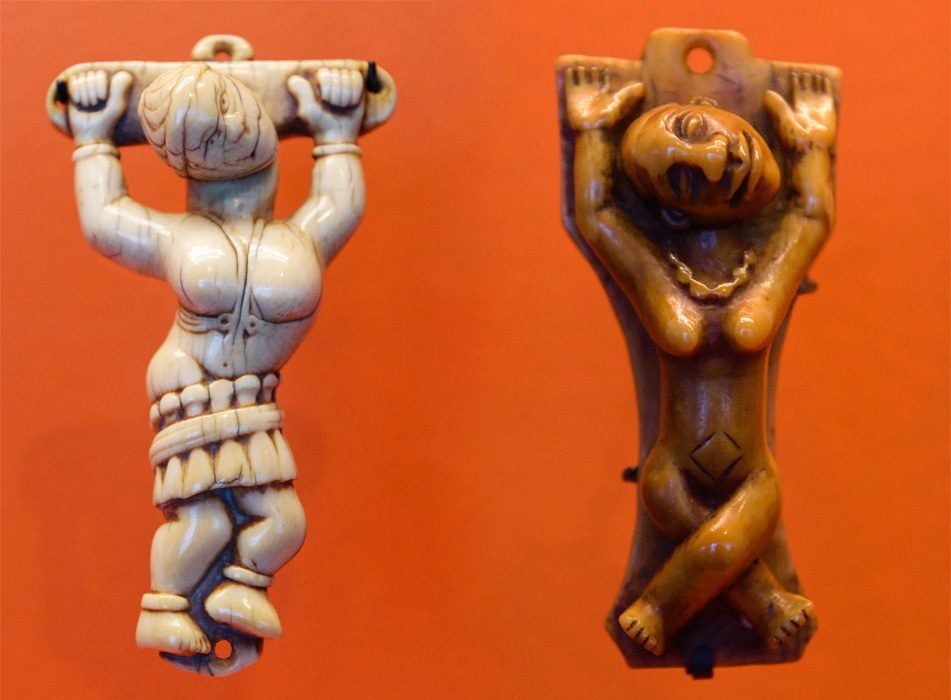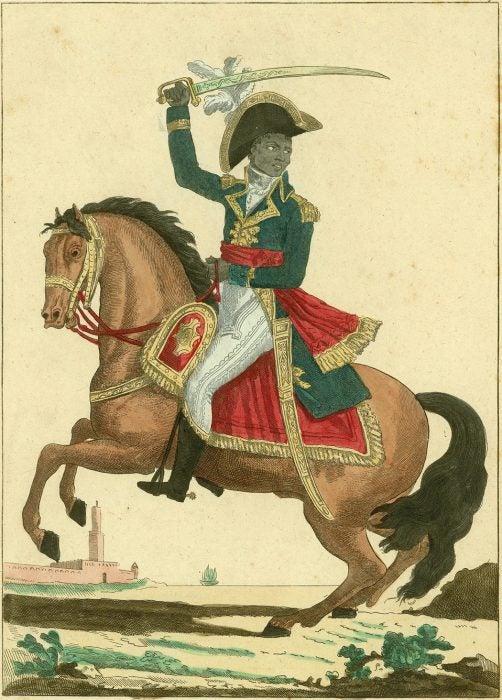DrBanneker
Space is the Place
Yes, it is a long-ish article but really interesting about the connections between a Congolese mystic, the Haitian Revolution, and a slave revolt in South Carolina
From JSTOR
Did Kongolese Catholicism Lead to Slave Revolutions?
The legacy of Kimpa Vita, a Kongolese Catholic mystic, was felt from the U.S. to Haiti.

Watercolor illustration of Kimpa Vita by Father Bernardo da Gallo, 1710
via Wikimedia Commons/Jonathan Aprea
By: Mohammed Elnaiem
February 6, 2019
9 minutes
Share Tweet Email Print
In 1966, Stokely Carmichael, a leader in the student non-violent coordinating committee, arrived at Berkeley calling for black power for black people. “The missionaries came with the Bible, and we had the land. When they left, they had the land, and we still have the Bible,” Carmichael declared with a snark characteristic of his charisma.
Three years later, in 1969, James Forman, a contemporary of Stokely Carmichael in the student civil rights movement, declared in his black manifesto that African Americans “were not Christians when we were brought to this country, but that Christianity was used to enslave us.”
Neither was entirely correct, but neither can be entirely dismissed. In truth, some African Americans were Christians when they arrived as slaves on the shores of North America. They were former subjects of the Christian Kingdom of Kongo, founded by Nzinga a Nkuwu, who was baptized in 1491. Nkuwu “rebranded” himself as King João after adopting the religion of the Portuguese missionaries. And sure enough, when these slaves later revolted, they were inspired by Kongolese Catholicism.
The church was often complicit in breaking long-established moral codes concerning the domestic slave trade.
Christianity arrived in Kongo at the very moment when Africans were kidnapped as slaves and brought to Portugal, in the middle of the fifteenth century. When the transatlantic slave trade took off, the west coast of Africa had already gone through an intense cultural transformation. In the Christian Kingdom of Kongo, an indigenous slave trade existed—as it did in much of the world then—but was bound by strict rules. Kongolese subjects could not be enslaved. Neither could women captured in war.

Watercolor by Bernardino d’Asti, ca. 1750
Linda Heywood, a professor of African-American history at Boston University, has written incredible work demonstrating the effects of the slave trade in transforming the Kingdom of Kongo from 1491 to 1800. In 1526, King Afonso of Kongo wrote to King João III of Portugal, complaining that Portuguese merchants were selling his subjects. He was especially offended that priests were buying women slaves for sex, and when he protested, he did so as a Christian.
The church was often complicit in breaking long-established moral codes concerning the domestic slave trade. In Kongo, first came the traders and slave captors, and then came the priests. And when Portugal wanted to trade, it refused to accept Nzimbu shells, the local currency, and demanded only slaves, incentivising the expansion of slavery. As Heywood insists:
[A]lthough Kongo had a vibrant cloth trade and also used ivory, copper and shells as money, from the very beginning of the trade Portuguese merchants reduced all money in Kongo to slaves.
European traders may have not brought slavery to the kingdom, nor did they cause what Heywood calls the “Kongo penchant for civil wars.” But they destabilised the kingdom, incentivised enslavement, and even funded those wars.
By the seventeenth century, when various kings claimed to be heirs to the Kongolese throne, enslavement was both common and lucrative. Europeans would trade weapons for slaves captured in war. By the beginning of the eighteenth century, a state of anarchy prevailed.
Enter Kimpa Vita
In 1684, Dona Beatriz (Kimpa Vita), a noble, was born in Kongo. She never had a formal education, but memorized important prayers in the local Kikongo language. In the 1690s, when a large civil war broke out in the duchy she resided in, she dreamt of restoring the Kingdom. She trained to be a Nganga, a medium to the other world. But by 1698, when Italian Capuchins, with the blessings of the papacy, stationed themselves in Kongo and declared a war against what they considered to be witchcraft, Dona Beatriz was discouraged from her training, lest she be deemed a sorcerer.
King Pedro had dominion over her land. It was he who invited the Italian Capuchins, for if they represented the Catholic Church, he would be favored by God. The Capuchins were led by the Italian Father Bernardo, soon to be Beatriz’s sworn enemy: In 1704, when Beatriz claimed she was the reincarnation of Saint Anthony, Bernardo was enraged.

Pendants with a feminine Christ that may represent the martyrdom of Kimpa Vita via Wikimedia Commons
Beatriz argued that Kongo needed black saints, that the Capuchins had been teaching a false Christianity, and that Jesus, Mary, and Saint Francis were in fact black and Kongolese. Everywhere she and her disciples went, they gained thousands of followers. Her followers could be found singing “Salve Antonia,” a prayer in Kikongo and a reworking of the Marian Hymn “Salve Regina.” Even Hippolita, King Pedro’s wife, would call herself a proud Antonian.
But the King, unamused, asked Father Bernardo to assess the validity of her claims. “Tell me, in Heaven are there blacks from Kongo, and if there are, do they still have their black color in Heaven?” the priest asked. To which she replied, without hesitation, “there are black Kongolese up in heaven.”
“If you are a woman, how then could you say you are Saint Anthony?”
“Saint Anthony came into my head to be able to preach in Kibangu.”
Father Bernardo advised the king to burn her at the stake, claiming that she was possessed by the Devil. The King was ecstatic: By late October of 1704, Beatriz had guided her followers to the abandoned capital, signifying the restoration of the kingdom. He wanted to be the unifier, and so, in 1706, Kimpa Vita was executed.
Did her movement survive? According to Heywood, “in the aftermath of the civil war in 1709 and the efforts of Pedro IV and the leaders who followed him to rid the kingdom of the supporters of the popular mystic Beatriz Kimpa Vita,” she writes, “Kongo ended up exporting more than 30,000 of its subjects.” Many of these slaves went to what would eventually become the United States. The fire of rebellion never left their hearts.
The Stono Rebellion
Thirty-three years after Kimpa Vita’s death, on Sunday, September 9, 1739, sixty slaves in South Carolina shocked the British colonists when they acquired arms and killed twenty-three slave owners. How is it that sixty-odd slaves in South Carolina found themselves able to acquire weaponry and use it?
John Thornton, a professor of African American Studies and History at Boston University has written groundbreaking work demonstrating the presence of Kongolese Christians in the Stono Rebellion. To Thornton, the answer might be simple: because they had military training in the civil wars of the Kongo. By 1740, England and Spain were close to war in North America. Eyewitness accounts seem to imply that the slaves who rebelled had come across Spanish propaganda. According to Thornton, they could interpret this propaganda, because at least some were likely bilingual, able to read Kikongo and Portuguese (Portuguese is the Iberian sister language to Spanish and shares much of its vocabulary).
In Stono, they dreamed of liberty. In Haiti, where a slave revolt led to the formation of a black republic, they won it.
Mark Smith, a professor of history at the University of South Carolina, seems to have uncovered even more of the mystery. “Why did the slaves revolt on the particular Sunday of September 9, 1739?” He insists that, quite simply, it was because “the Kongolese knew their Catholic calendar.” The slaves prepared the revolt the day before, on the birthday of the Virgin Mary, the so-called day of nativity. Smith implies a potential connection with Kimpa Vita. Because Kimpa Vita revered the Virgin Mary as a saint, he argues that it was possibly her movement that imbued Mary’s spirit with a revolutionary and emancipatory power.
Smith was also struck by the word Lukangu, which was chanted by the slaves to mean “liberty” as they revolted. Its root comes from the word Kanga, a messianic rendition of the word for “salvation.” This is striking, because it was a word used heavily in the Salve Antoniana. In Stono, they dreamed of liberty. In Haiti, where a slave revolt led to the formation of a black republic, they won it.
The Haitian Revolution
“I am the subject of three kings: of the King of Congo, master of all the blacks; of the King of France who represents my father; of the King of Spain who represents my mother.” These were the peculiar words that Macaya, one of the commanders of a black revolutionary contingent, penned in a letter to the republican commissioners on Saint Domingue, a French-Caribbean colony. Fifty-four years had passed since the Stono Rebellion, and slaves were fomenting a revolt. The French revolutionaries were caught off guard. Were slaves not human beings? As a result, didn’t the Declaration of the Rights of Man apply to them too?
The letter-writer’s homage to the king of Kongo should come as no surprise. In an analysis of historiographical debates, primary documents, and statistical data, Christopher Davis, a lecturer at University of North Carolina at Greensboro, concluded that “the majority of the West Central Africans who were brought to Saint Domingue were Kongolese.” The colony got its steady supply of slaves from Kongo’s latest civil war. By 1779, the Kongolese either pledged allegiance to King Pedro V or to José I. If captured, whether as civilians or in war, they would likely be sold as slaves. It was about 73 years after Kimpa Vita was burnt at the stake, and the Kingdom still hadn’t gotten its act together.
From JSTOR
Did Kongolese Catholicism Lead to Slave Revolutions?
The legacy of Kimpa Vita, a Kongolese Catholic mystic, was felt from the U.S. to Haiti.

Watercolor illustration of Kimpa Vita by Father Bernardo da Gallo, 1710
via Wikimedia Commons/Jonathan Aprea
By: Mohammed Elnaiem
February 6, 2019
9 minutes
Share Tweet Email Print
In 1966, Stokely Carmichael, a leader in the student non-violent coordinating committee, arrived at Berkeley calling for black power for black people. “The missionaries came with the Bible, and we had the land. When they left, they had the land, and we still have the Bible,” Carmichael declared with a snark characteristic of his charisma.
Three years later, in 1969, James Forman, a contemporary of Stokely Carmichael in the student civil rights movement, declared in his black manifesto that African Americans “were not Christians when we were brought to this country, but that Christianity was used to enslave us.”
Neither was entirely correct, but neither can be entirely dismissed. In truth, some African Americans were Christians when they arrived as slaves on the shores of North America. They were former subjects of the Christian Kingdom of Kongo, founded by Nzinga a Nkuwu, who was baptized in 1491. Nkuwu “rebranded” himself as King João after adopting the religion of the Portuguese missionaries. And sure enough, when these slaves later revolted, they were inspired by Kongolese Catholicism.
The church was often complicit in breaking long-established moral codes concerning the domestic slave trade.
Christianity arrived in Kongo at the very moment when Africans were kidnapped as slaves and brought to Portugal, in the middle of the fifteenth century. When the transatlantic slave trade took off, the west coast of Africa had already gone through an intense cultural transformation. In the Christian Kingdom of Kongo, an indigenous slave trade existed—as it did in much of the world then—but was bound by strict rules. Kongolese subjects could not be enslaved. Neither could women captured in war.

Watercolor by Bernardino d’Asti, ca. 1750
Linda Heywood, a professor of African-American history at Boston University, has written incredible work demonstrating the effects of the slave trade in transforming the Kingdom of Kongo from 1491 to 1800. In 1526, King Afonso of Kongo wrote to King João III of Portugal, complaining that Portuguese merchants were selling his subjects. He was especially offended that priests were buying women slaves for sex, and when he protested, he did so as a Christian.
The church was often complicit in breaking long-established moral codes concerning the domestic slave trade. In Kongo, first came the traders and slave captors, and then came the priests. And when Portugal wanted to trade, it refused to accept Nzimbu shells, the local currency, and demanded only slaves, incentivising the expansion of slavery. As Heywood insists:
[A]lthough Kongo had a vibrant cloth trade and also used ivory, copper and shells as money, from the very beginning of the trade Portuguese merchants reduced all money in Kongo to slaves.
European traders may have not brought slavery to the kingdom, nor did they cause what Heywood calls the “Kongo penchant for civil wars.” But they destabilised the kingdom, incentivised enslavement, and even funded those wars.
By the seventeenth century, when various kings claimed to be heirs to the Kongolese throne, enslavement was both common and lucrative. Europeans would trade weapons for slaves captured in war. By the beginning of the eighteenth century, a state of anarchy prevailed.
Enter Kimpa Vita
In 1684, Dona Beatriz (Kimpa Vita), a noble, was born in Kongo. She never had a formal education, but memorized important prayers in the local Kikongo language. In the 1690s, when a large civil war broke out in the duchy she resided in, she dreamt of restoring the Kingdom. She trained to be a Nganga, a medium to the other world. But by 1698, when Italian Capuchins, with the blessings of the papacy, stationed themselves in Kongo and declared a war against what they considered to be witchcraft, Dona Beatriz was discouraged from her training, lest she be deemed a sorcerer.
King Pedro had dominion over her land. It was he who invited the Italian Capuchins, for if they represented the Catholic Church, he would be favored by God. The Capuchins were led by the Italian Father Bernardo, soon to be Beatriz’s sworn enemy: In 1704, when Beatriz claimed she was the reincarnation of Saint Anthony, Bernardo was enraged.

Pendants with a feminine Christ that may represent the martyrdom of Kimpa Vita via Wikimedia Commons
Beatriz argued that Kongo needed black saints, that the Capuchins had been teaching a false Christianity, and that Jesus, Mary, and Saint Francis were in fact black and Kongolese. Everywhere she and her disciples went, they gained thousands of followers. Her followers could be found singing “Salve Antonia,” a prayer in Kikongo and a reworking of the Marian Hymn “Salve Regina.” Even Hippolita, King Pedro’s wife, would call herself a proud Antonian.
But the King, unamused, asked Father Bernardo to assess the validity of her claims. “Tell me, in Heaven are there blacks from Kongo, and if there are, do they still have their black color in Heaven?” the priest asked. To which she replied, without hesitation, “there are black Kongolese up in heaven.”
“If you are a woman, how then could you say you are Saint Anthony?”
“Saint Anthony came into my head to be able to preach in Kibangu.”
Father Bernardo advised the king to burn her at the stake, claiming that she was possessed by the Devil. The King was ecstatic: By late October of 1704, Beatriz had guided her followers to the abandoned capital, signifying the restoration of the kingdom. He wanted to be the unifier, and so, in 1706, Kimpa Vita was executed.
Did her movement survive? According to Heywood, “in the aftermath of the civil war in 1709 and the efforts of Pedro IV and the leaders who followed him to rid the kingdom of the supporters of the popular mystic Beatriz Kimpa Vita,” she writes, “Kongo ended up exporting more than 30,000 of its subjects.” Many of these slaves went to what would eventually become the United States. The fire of rebellion never left their hearts.
The Stono Rebellion
Thirty-three years after Kimpa Vita’s death, on Sunday, September 9, 1739, sixty slaves in South Carolina shocked the British colonists when they acquired arms and killed twenty-three slave owners. How is it that sixty-odd slaves in South Carolina found themselves able to acquire weaponry and use it?
John Thornton, a professor of African American Studies and History at Boston University has written groundbreaking work demonstrating the presence of Kongolese Christians in the Stono Rebellion. To Thornton, the answer might be simple: because they had military training in the civil wars of the Kongo. By 1740, England and Spain were close to war in North America. Eyewitness accounts seem to imply that the slaves who rebelled had come across Spanish propaganda. According to Thornton, they could interpret this propaganda, because at least some were likely bilingual, able to read Kikongo and Portuguese (Portuguese is the Iberian sister language to Spanish and shares much of its vocabulary).
In Stono, they dreamed of liberty. In Haiti, where a slave revolt led to the formation of a black republic, they won it.
Mark Smith, a professor of history at the University of South Carolina, seems to have uncovered even more of the mystery. “Why did the slaves revolt on the particular Sunday of September 9, 1739?” He insists that, quite simply, it was because “the Kongolese knew their Catholic calendar.” The slaves prepared the revolt the day before, on the birthday of the Virgin Mary, the so-called day of nativity. Smith implies a potential connection with Kimpa Vita. Because Kimpa Vita revered the Virgin Mary as a saint, he argues that it was possibly her movement that imbued Mary’s spirit with a revolutionary and emancipatory power.
Smith was also struck by the word Lukangu, which was chanted by the slaves to mean “liberty” as they revolted. Its root comes from the word Kanga, a messianic rendition of the word for “salvation.” This is striking, because it was a word used heavily in the Salve Antoniana. In Stono, they dreamed of liberty. In Haiti, where a slave revolt led to the formation of a black republic, they won it.
The Haitian Revolution
“I am the subject of three kings: of the King of Congo, master of all the blacks; of the King of France who represents my father; of the King of Spain who represents my mother.” These were the peculiar words that Macaya, one of the commanders of a black revolutionary contingent, penned in a letter to the republican commissioners on Saint Domingue, a French-Caribbean colony. Fifty-four years had passed since the Stono Rebellion, and slaves were fomenting a revolt. The French revolutionaries were caught off guard. Were slaves not human beings? As a result, didn’t the Declaration of the Rights of Man apply to them too?
The letter-writer’s homage to the king of Kongo should come as no surprise. In an analysis of historiographical debates, primary documents, and statistical data, Christopher Davis, a lecturer at University of North Carolina at Greensboro, concluded that “the majority of the West Central Africans who were brought to Saint Domingue were Kongolese.” The colony got its steady supply of slaves from Kongo’s latest civil war. By 1779, the Kongolese either pledged allegiance to King Pedro V or to José I. If captured, whether as civilians or in war, they would likely be sold as slaves. It was about 73 years after Kimpa Vita was burnt at the stake, and the Kingdom still hadn’t gotten its act together.

